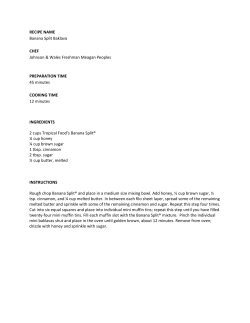
Document 145111
Client Name ______________________________________ Date ________________ RD/DTR ______________________________________________________________ Email ____________________________________ Phone ______________________ Low-Potassium Nutrition Therapy What Is Potassium? Potassium is an important nutrient that is found in most foods. Fruits, vegetables, nuts, and milk are highest in potassium. Why Does My Child Need a Low-potassium Diet? When the kidneys are not working, the body does not get rid of extra potassium through urine. If extra potassium builds up in the bloodstream, it can cause very serious heart problems. During dialysis, the body gets rid of extra potassium with each dialysis treatment. However, potassium can easily reach dangerously high levels between treatments if you get too much potassium from food. Meal Planning Tips • • • • Choose fruits and vegetables that are lowest in potassium (see lists in this handout). Limit your child to no more than 2 to 3 servings of higher-potassium fruits and vegetables. Limit milk, yogurt, and pudding to 1 cup daily. Avoid 100% fruit juices and dried fruits. Fruit drinks such as lemonade and cranberry juice cocktail have very little potassium. • Soak potatoes and other vegetables to decrease the potassium content. o Peel vegetables and cut into pieces that are approximately ⅛-inch thick. o Rinse and soak the vegetable pieces in warm water for at least 2 hours (use 10 cups water for every 1 cup of vegetables). o Drain and rinse soaked vegetables under warm water. o Boil vegetables for 5 minutes (use 5 cups water for every 1 cup of vegetables). o Use soaked vegetables in soups and stews, or they can be scalloped, mashed, or fried. Notes: Copyright American Dietetic Association. This handout may be duplicated for client education. Chronic Kidney Disease Low-Potassium Nutrition Therapy—Page 1 Low-Potassium Fruits (0-200 mg per Serving) Fruit (Serving Size) Potassium (mg) per Serving 160 90 140 130 150 67 Apple (1 medium or 1 cup) Applesauce (½ cup) Blackberries (½ cup) Blueberries (1 cup) Cherries (10 or 2 ounces) Cranberries, raw, whole (1cup or 3ounces) Fruit cocktail (½ cup) Grapes, seedless (10) Grapefruit (½ medium or 4 ounces) Kiwi (½ medium or 1.3 ounces) Mango (½ medium or 3.5 ounces) Pears, canned (½ cup) Peach (1 medium or 3 ounces) Pineapple (½ cup) Plums, canned in syrup (½ cup) Raspberries (½ cup) Rhubarb, cooked (½ cup) Tangerine (1 medium or 3 ounces) Watermelon (1 cup) 115 90 170 126 160 90 198 90 115 95 115 130 175 Low-Potassium Vegetables (0-200 mg per Serving) Vegetable (Serving Size) Alfalfa sprouts (½ cup) Asparagus (4 spears or 2 ounces) Bean sprouts (mung), raw (1 cup) Bean sprouts (soybeans), raw (½ cup) Broccoli, cooked (½ cup or 3.2 ounces) Cabbage, raw, red/green (1 cup) Cauliflower, raw (½ cup) Carrots raw (½ cup) Celery, raw (7.5-inch stalk) Collards, boiled (1 cup) Corn, frozen, boiled (½ cup) Cucumber, with peel (¼ or 2-inch piece) Potassium (mg) per Serving 15 130 155 170 166 172 150 180 115 170 121 108 Low-Potassium Nutrition Therapy—Page 2 Cucumber, without peel (¼ or 2-inch piece) Eggplant, cooked (½ cup) Garlic (4 cloves) Green beans, fresh, boiled (½ cup) Green beans, frozen, boiled (½ cup) Lettuce, butter head (1 cup) Lettuce, iceberg (1 cup chopped) Lettuce, loose leaf (1 cup) Lettuce, romaine (1 cup) Mixed vegetables, frozen (½ cup) Okra, boiled (½ cup) Onion, raw, chopped (¼ cup) Pepper, bell (½ medium or 2 ounces) Radishes (10 or 1.5 ounces) Rutabagas, raw (1 cup) Spaghetti squash, baked (1 cup) Summer squash, raw, sliced (½ cup) Squash, zucchini, raw, sliced (½ cup) Turnip, cooked (½ cup) Water chestnut, canned (½ cup) 75 125 50 187 85 141 87 148 162 155 135 63 106 105 150 181 110 140 105 85 High-Potassium Fruits (More than 200 mg per Serving) Fruit (Serving Size) Apricots (3 medium or 3.5 ounces) Avocado (¼ medium or 1.5 ounces) Banana (1medium or 4 ounces) Cantaloupe (½ cup) Dates, dried (5 medium or 1.4 ounces) Honeydew (½ cup) Orange (1 medium or 4.4 ounces) Papaya (½ med/5 ounces) Pear, fresh (1 medium or 5.5 ounces) Plums (2 medium or 4.4 ounces) Prunes (5 medium or 1.4 ounces) Raisins (¼ cup or 1.3 ounces) 100% fruit juice (1 cup) Potassium (mg) per Serving 315 275 450 245 350 230 235 390 210 220 315 310 300-500 Low-Potassium Nutrition Therapy—Page 3 High-Potassium Vegetables (More than 200 mg per Serving) Vegetable (Serving Size) Potassium (mg) per Serving 265 Artichoke (¼ medium or 2.5 ounces) Beans: Kidney, canned (½ cup) 330 Lima, canned (½ cup) 265 Navy, canned (½ cup) 380 Pinto, canned (½ cup) 290 Beets, boiled (½ cup) 260 Brussels sprouts (½ cup) 247 Chard, swiss, boiled (½ cup) 430 Corn, fresh, boiled (½ cup) 204 Mushrooms, raw (½ cup) 259 Peas, dried, cooked: Blackeyed peas (½ cup) 240 Chickpeas/garbanzo (½ cup) 240 Lentils (½ cup) 365 Split peas (½ cup) 355 Potatoes, all types, baked with skin 759 (1 small or 4.9 ounces) Potatoes, all types, boiled without skin 457 (1 small or 4.9 ounces) Sweet potatoes , baked with skin (1 medium or 4 ounces) 397 Sweet potatoes, boiled or mashed (½ cup) 302 Tomato, raw, chopped (1 cup) 273 Tomato puree, canned (¼ cup) 266 Winter squash, baked (½ cup) 450 Yam, baked or boiled (½ cup) 456 Potassium values from Pennington JAT, Douglas AD. Bowes & Church’s Food Values of Portions Commonly Used. 18th ed. New York, NY: Lippincott Williams & Wilkins; 2005. Notes: Low-Potassium Nutrition Therapy—Page 4
© Copyright 2025








